Grounding and bonding a standby system are essential for safety, equipment protection, and compliance. Proper grounding provides a safe path for fault currents, while bonding ensures all metal parts are connected, preventing voltage differences. Avoid common mistakes like faulty connections or ignoring standards, which can lead to hazards. Using correct components and following established procedures guarantees system reliability. Stick with the essentials, and you’ll discover how to effectively implement these practices for a safer, compliant system.
Key Takeaways
- Proper grounding provides a safe fault current path, protecting personnel and equipment during system faults.
- Effective bonding ensures all metallic parts are electrically connected, preventing dangerous voltage differences.
- Use appropriate grounding electrodes, conductors, and connectors compliant with electrical codes for safety.
- Regularly inspect and verify grounding and bonding connections to maintain system integrity and safety.
- Adhering to standards and avoiding grounding myths reduce risks and ensure reliable standby system operation.
Understanding the Role of Grounding in Standby Systems
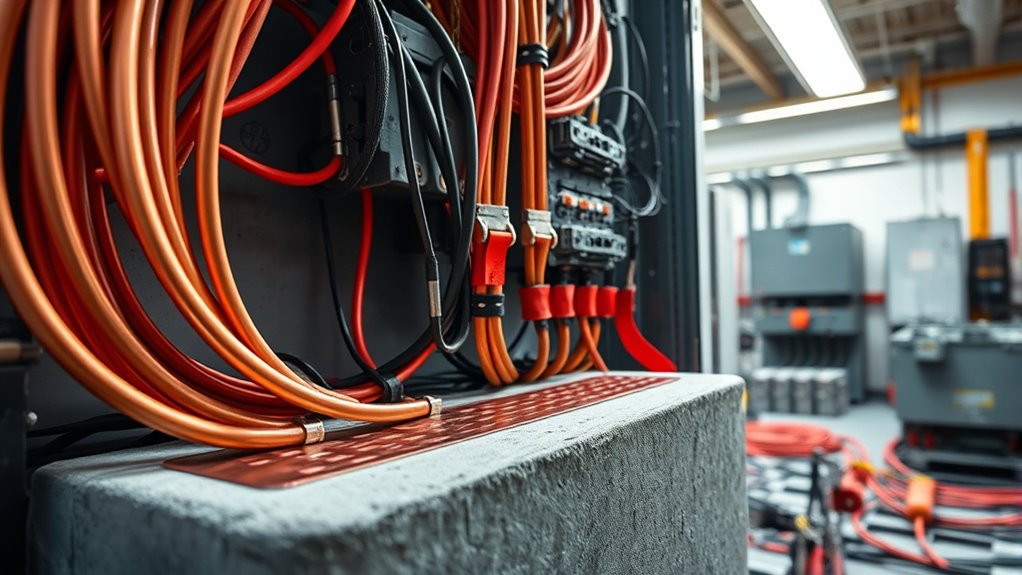
Understanding the role of grounding in standby systems is essential for ensuring safety and reliable operation. Your grounding system design provides a safe pathway for fault currents, helping to protect personnel and equipment. Proper grounding minimizes the risk of electric shock and prevents damage caused by electrical faults. By following electrical safety protocols, you ascertain that the standby system remains stable and effective during power outages or faults. A well-designed grounding system helps to clear faults quickly, reducing downtime and potential hazards. It also ensures that all system components are at the same electrical potential, preventing dangerous voltage differences. Additionally, high contrast ratios can improve the visibility of safety indicators and system statuses, enhancing overall safety awareness. Ultimately, a solid grounding foundation enhances both safety and system dependability, making it a critical aspect of standby system installation and maintenance.
The Importance of Proper Bonding Practices
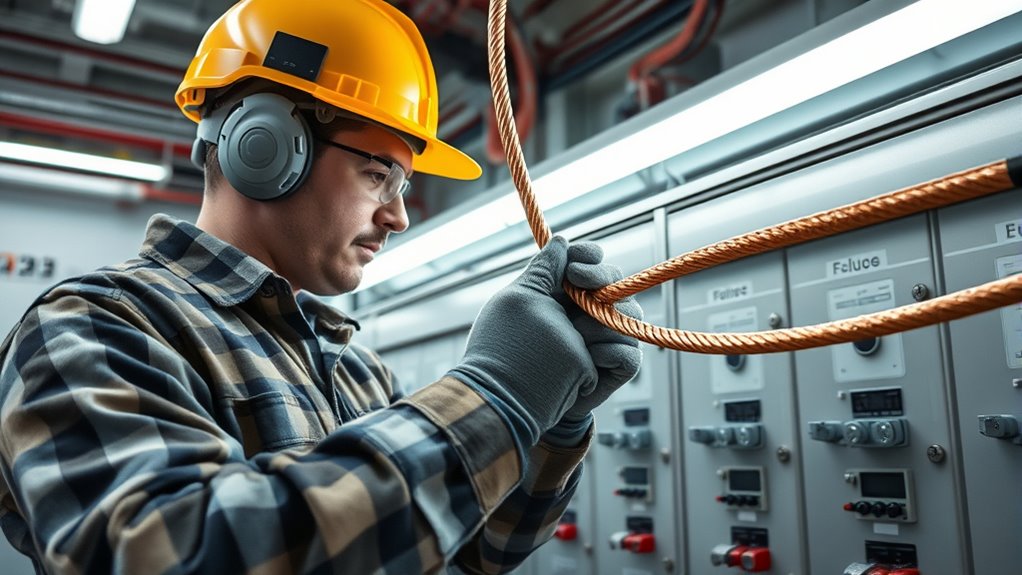
Proper bonding practices are vital for guaranteeing the safety and reliability of your standby system. When you follow correct bonding procedures, you create a solid electrical connection that prevents dangerous voltage buildup. Proper bonding ensures grounding equipment works effectively, reducing the risk of electric shock and equipment damage. Neglecting these practices can lead to costly failures and safety hazards. By adhering to established standards, you protect everyone around your system and maintain operational integrity. Remember, consistent bonding practices help maintain a low-resistance path for fault currents, ensuring quick system response. Regular inspections help identify potential issues before they become critical.
- Feel confident that your grounding equipment performs as intended during emergencies
- Protect your team from electrical shocks and potential injuries
- Keep your system compliant and avoid costly penalties
Components Involved in Grounding and Bonding

To guarantee your standby system is safely grounded and properly bonded, you need to be familiar with its key components. These include grounding electrodes, grounding conductors, and bonding materials. Grounding electrodes, like grounding rods or plates, establish a connection to the earth, helping to prevent electrical shock hazards. The grounding conductors carry fault currents safely away from equipment. Bonding materials, such as copper or aluminum conductors, ensure all metallic parts are connected, minimizing potential differences. Be aware of grounding myths—that certain materials or methods are universally effective—since the right bonding materials depend on your system’s specifics. Proper selection and installation of these components are critical for safety and system reliability. Understanding these essentials helps you avoid common pitfalls and ensures your system is correctly grounded and bonded. Additionally, awareness of specific component functions can significantly enhance your system’s overall safety and performance.
Step-by-Step Guide to Grounding a Standby System
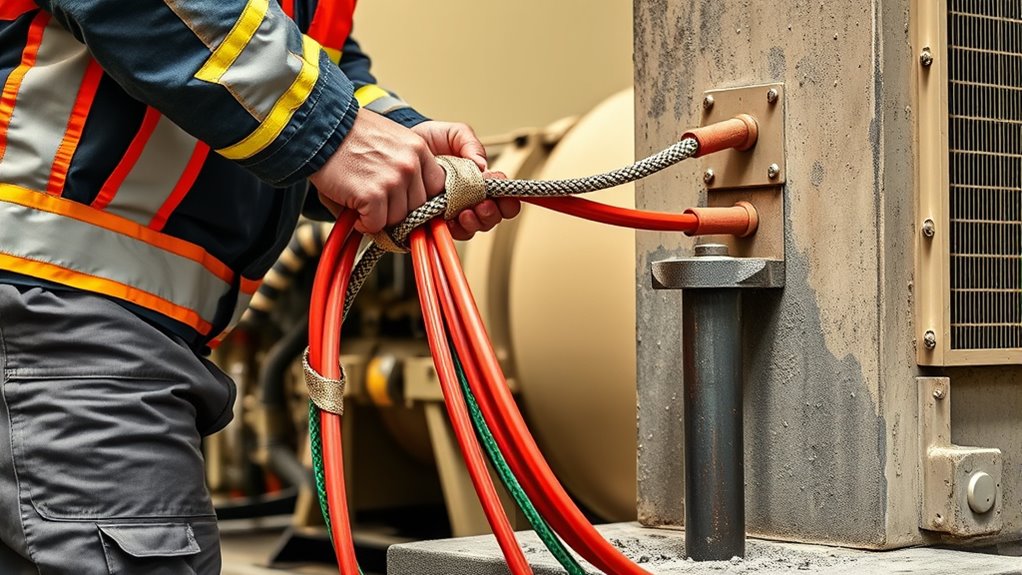
Grounding a standby system requires careful planning and precise execution to guarantee safety and reliability. To make certain your setup supports solar integration and provides emergency power, follow these steps:
- Identify the proper grounding point that connects the system to the building’s grounding electrode system, ensuring a solid reference for fault currents.
- Install grounding conductors securely, maintaining low impedance pathways essential during power surges or faults.
- Verify grounding connections regularly, especially after maintenance or modifications, to prevent unexpected failures during critical moments like outages.
- Proper grounding angles can significantly influence the performance and safety of the system, highlighting the importance of correct installation techniques.
Techniques for Effective Bonding in Standby Setups

To guarantee your standby system is properly bonded, selecting the right equipment is essential. You also need to establish clear, low-resistance bonding pathways to maintain safety and reliability. Focusing on these key points helps create an effective and compliant bonding setup. Additionally, understanding size restrictions for tiny houses can influence the selection of appropriate grounding methods to ensure compliance with local regulations.
Proper Equipment Selection
Selecting the right equipment is crucial for guaranteeing effective bonding in standby systems. You must choose grounding wire selection that is durable, conductive, and compatible with your system’s components. Equally important is verifying bonding material compatibility to prevent corrosion and guarantee a reliable connection. When selecting equipment, consider these key aspects:
- Use materials proven to withstand environmental stresses and electrical loads.
- Match bonding materials with existing system components to avoid chemical reactions.
- Prioritize high-quality connectors and clamps for secure, long-lasting bonds.
- Incorporating for sale 100 options can ensure you select quality materials within your budget.
Clear Bonding Pathways
Establishing clear bonding pathways is essential for ensuring a reliable standby system. Proper bonding techniques minimize potential differences, reduce electrical noise, and improve safety. Avoid grounding myths that suggest complicated or unnecessary connections; instead, focus on straightforward, effective bonding methods. Use a single, continuous conductor to connect all grounding points, ensuring low resistance paths. To enhance understanding, consider this table:
| Bonding Technique | Key Benefit |
|---|---|
| Solid Conductors | Low impedance, reliable connection |
| Multiple Bonds | Redundancy for safety |
Additionally, using proper grounding practices ensures the system maintains safety standards and optimal performance.
Common Mistakes and How to Avoid Them
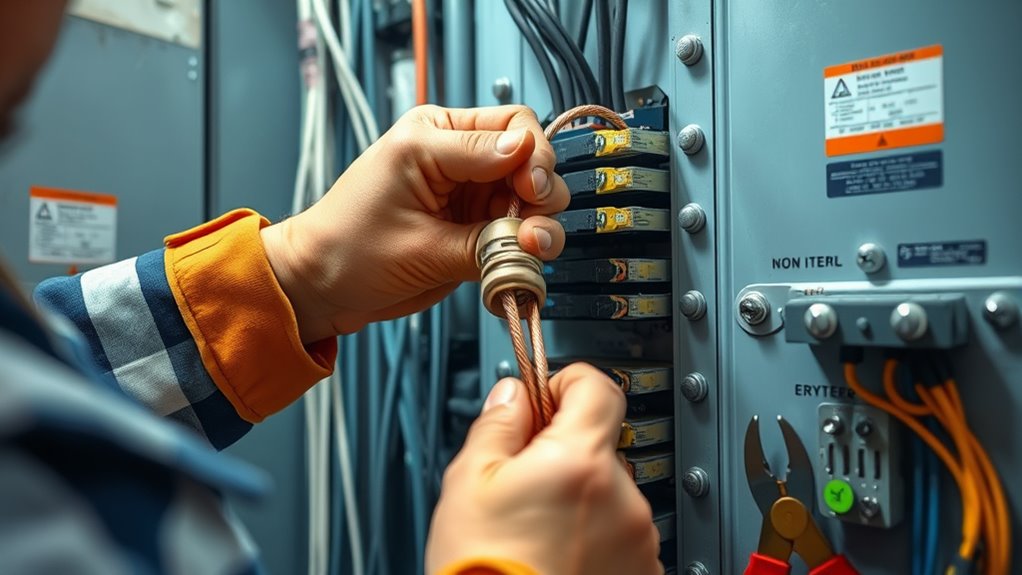
One common mistake is making improper grounding connections, which can jeopardize safety and system performance. Another issue is using inadequate bonding practices, leading to potential electrical faults. To avoid these, guarantee all connections are solid and follow established standards precisely. Incorporating proper sound healing science principles can also enhance system reliability and health.
Improper Grounding Connections
Improper grounding connections are a common mistake that can compromise the safety and reliability of a standby system. Many believe grounding myths, such as thinking a quick connection suffices or that bonding isn’t essential, leading to dangerous setups. These misconceptions can cause severe safety hazards, including electrical shock and system failure. To avoid these mistakes, make certain that grounding and bonding are correctly implemented according to code. Remember, bonding myths can tempt you into shortcuts that jeopardize system integrity. Ensuring proper mindfulness during installation helps maintain safe and effective grounding practices.
- Neglecting proper grounding points can leave your system vulnerable to surges and faults.
- Using incorrect or damaged connectors can disconnect your system from a reliable ground.
- Relying on myths instead of standards risks unsafe, non-compliant installations.
Inadequate Bonding Practices
Inadequate bonding practices are among the most common mistakes that compromise the safety and effectiveness of a standby system. Many people fall for grounding myths, believing that grounding alone guarantees safety, but bonding is equally critical. Bonding myths often lead to overlooked connections or skipped steps, creating potential hazards. Proper bonding ensures all system components are electrically connected, reducing the risk of stray currents and shock. To avoid these mistakes, double-check your bonding connections, use the correct materials, and follow the electrical code requirements. Remember, bonding isn’t optional; it’s essential for system safety. Educate yourself on grounding and bonding practices, and don’t assume myths will protect your system. Understanding bonding principles helps ensure your system is both safe and compliant. Clear, correct bonding practices keep your standby system safe and compliant.
Ensuring Compliance With Electrical Codes and Standards
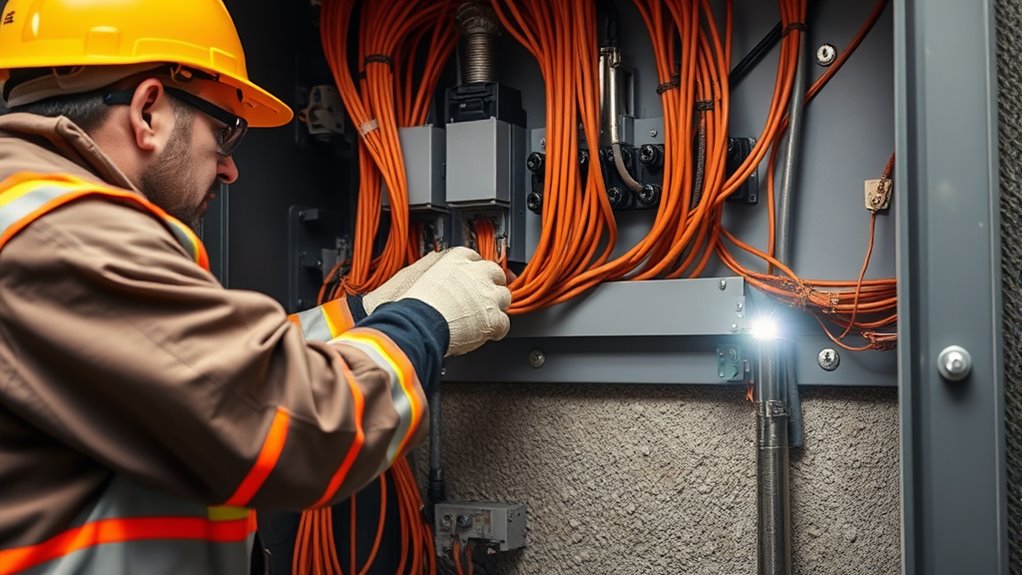
To guarantee your standby system meets safety and reliability requirements, you must adhere to all relevant electrical codes and standards. Understanding grounding myths and bonding myths helps prevent dangerous assumptions that could compromise safety. By following established regulations, you ensure proper grounding and bonding practices that protect both personnel and equipment.
Remember, ignoring these standards can lead to costly failures or hazards. Stay informed and consult the latest codes to avoid common pitfalls.
- Feel confident knowing your system is safe and compliant, not just checked off a list.
- Avoid the fear of accidental violations that threaten your safety and operations.
- Empower yourself with knowledge to prevent grounding myths and bonding myths from putting everyone at risk.
Frequently Asked Questions
How Often Should Grounding and Bonding Systems Be Inspected?
You should inspect your grounding and bonding systems at least once a year, following recommended maintenance schedules. Regular inspections help identify corrosion, loose connections, or damage that could compromise safety. If your system experiences frequent power outages or environmental conditions change, consider more frequent checks. Staying proactive guarantees your standby system remains reliable and compliant with safety standards, minimizing risks during critical operations.
Can Improper Grounding Cause Standby System Failures?
Think of improper grounding as leaving a dam half-built—you risk a flood. Yes, it can cause standby system failures, because corrosion can weaken connections and lightning protection becomes ineffective. When grounding isn’t solid, electrical surges find unintended pathways, leading to equipment damage or failure. Without proper grounding, your system’s reliability is like a house of cards, vulnerable to the storm of electrical faults and lightning strikes.
What Safety Precautions Are Necessary During Grounding and Bonding?
During grounding and bonding, you should always wear proper personal protective equipment and verify connections before working. Use insulated tools to prevent electrical noise, which can interfere with system operation. Confirm lightning protection measures are in place to guard against surges. Keep grounding conductors clear of corrosion and physical damage, and follow all safety procedures to prevent shock hazards and ensure a reliable standby system.
Are There Specific Tools Recommended for Grounding and Bonding?
You should use specialized grounding equipment like grounding rods, clamps, and conductors to guarantee proper safety. For bonding techniques, utilize approved bonding straps and connectors that create continuous electrical paths. These tools help you reliably establish grounding and bonding connections, minimizing electrical hazards. Always choose equipment rated for your system’s voltage and current, and follow manufacturer instructions to ensure safe, effective grounding and bonding during standby system setup.
How Does Grounding Impact the Overall Safety of Standby Systems?
Grounding greatly enhances your standby system’s safety by preventing electrical shock and ensuring proper fault current flow. Many grounding myths persist, but using effective bonding techniques ensures all metallic parts stay at the same potential, reducing shock risks. Proper grounding not only protects equipment but also safeguards you. Don’t rely on myths—follow proven bonding techniques to maintain a safe, reliable standby system that minimizes hazards and ensures quick fault clearance.
Conclusion
By mastering grounding and bonding, you reveal the secret to a safer, unstoppable standby system that can withstand the fiercest electrical storms. Skimping on proper practices risks catastrophic failures, system chaos, and endangering lives. When every wire is correctly grounded and bonded, you create an impenetrable fortress of safety, ensuring your system’s resilience against any power outage or electrical mishap. Don’t leave safety to chance—make grounding and bonding your ultimate defense against disaster!









